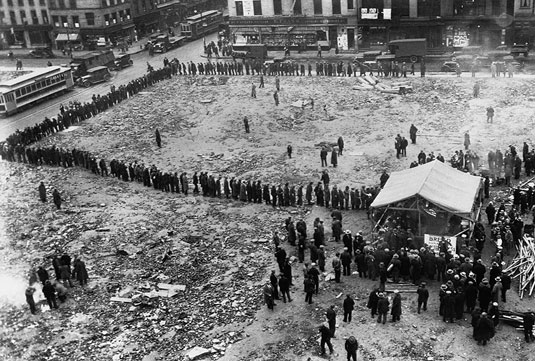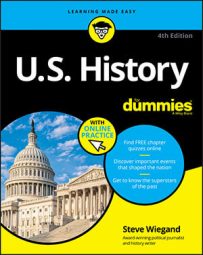Economists have argued ever since as to just what caused it. But it’s safe to say that a bunch of intertwined factors contributed. Among them were:
-
The stock market crash. The stock market soared throughout most of the 1920s, and the more it grew, the more people were eager to pour money into it. Many people bought on margin, which meant they paid only part of a stock’s worth when they bought it and the rest when they sold it. That worked fine as long as stock prices kept going up.
But when the market crashed in late October 1929, they were forced to pay up on stocks that were worth far less than what they had paid for them. Many had borrowed to buy stock, and when the stock market went belly-up, they couldn’t repay their loans and the lenders were left holding the empty bag.
-
Bank failures. Many small banks, particularly in rural areas, had overextended credit to farmers who, for the most part, had not shared in the prosperity of the 1920s and often could not repay the loans. Big banks, meanwhile, had foolishly made huge loans to foreign countries. Why? So the foreign countries could repay their earlier debts from World War I.
When times got tough and U.S. banks stopped lending, European nations simply defaulted on their outstanding loans. As a result, many banks went bankrupt. Others were forced out of business when depositors panicked and withdrew their money. The closings and panics almost completely shut down the country’s banking system.
-
Too many poor people. That may sound sort of goofy, but it’s a real reason. While the overall economy had soared in the 1920s, most of the wealth was enjoyed by relatively few Americans. In 1929, 40 percent of the families in the country were still living at or below the poverty level.
That made them too poor to buy goods and services and too poor to pay their debts. With no markets for their goods, manufacturers had to lay off tens of thousands of workers, which, of course, just created more poor people.
-
Farm failures. Many American farmers were already having a hard time before the Depression, mostly because they were producing too much and farm product prices were too low. The situation was so bad in some areas that farmers burned corn for fuel rather than sell it.
-
Environmental disasters. The production of vast crops during World War I and the decade that followed resulted in over-plowing of much of America’s farmland. The prairie grasses that held topsoil in place were stripped.
Coupled with one of the worst droughts in recorded history, the unprotected soil turned the Great Plains into what would become known as the “Dust Bowl.” Dry winds picked up tons of topsoil and blew it across the prairies, creating huge, suffocating clouds of dirt that buried towns and turned farms into deserts.
-
Government inaction. Rather than try to jumpstart the economy by pushing the Federal Reserve System to lend money to banks at low interest rates and pumping money into the economy through federal public works projects, the Hoover Administration did nothing at first, then took small and tentative actions that weren’t enough to head things off.
Whatever the causes, the consequences of the Great Depression were staggering. In the cities, thousands of jobless men roamed the streets looking for work. It wasn’t unusual for 2,000 or 3,000 applicants to show up for one or two job openings. If they weren’t looking for work, they were looking for food.
Bread lines were established to prevent people from starving. And more than a million families lost their houses and took up residence in shantytowns made up of tents, packing crates, and the hulks of old cars. They were called “Hoovervilles,” a mocking reference to President Hoover, whom many blamed (somewhat unfairly) for the mess the country was experiencing. ©Bettmann/CORBIS
©Bettmann/CORBISMany wait hours in line for bread.
Americans weren’t sure what to do. In the summer of 1932, about 20,000 desperate World War I veterans marched on Washington D.C. to claim $1,000 bonuses they had been promised they would get, starting in 1946. When Congress refused to move up the payment schedules, several thousand members of the “Bonus Army” built a camp of tents and shacks on the banks of the Potomac River and refused to leave.
Under orders of President Hoover, federal troops commanded by Gen. Douglas MacArthur used bayonets and gas bombs to rout the squatters. The camp was burned. No one was killed, but the episode left a bad taste in the mouths of many Americans.Thousands of farmers left their homes in states like Oklahoma and Arkansas and headed for the promise of better days in the West, especially California. What they found there, however, was most often a backbreaking existence as migrant laborers, living in squalid camps and picking fruit for starvation wages.

